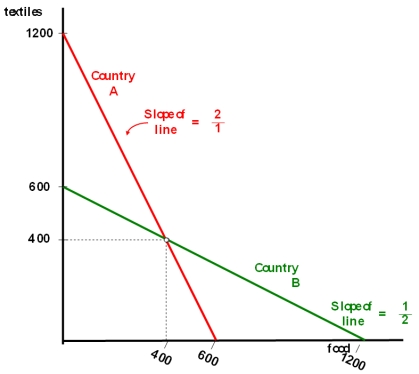Multiple Choice
Counties A and B currently consume 400 units of food and 400 units of textiles each and currently do not trade with one another.The citizens of country A have to give up one unit of food to gain two units of textiles,while the citizens of country B have to give up one unit of textiles to gain two units of food.Their production possibilities curves are shown.  Under the theory of comparative advantage,if free trade is allowed,the market clearing price (or exchange rate if you will) between food and textiles will be
Under the theory of comparative advantage,if free trade is allowed,the market clearing price (or exchange rate if you will) between food and textiles will be
A) one unit of food for one unit of textiles.
B) somewhere between one unit of food for two units of textiles and two units of food for one unit of textiles.
C) one unit of food for two units of textiles.
D) two units of food for one unit of textiles.
Correct Answer:

Verified
Correct Answer:
Verified
Q9: A purely domestic firm sources its products,sells
Q25: A true MNC, with operations in dozens
Q38: Recently, financial markets have become highly integrated.
Q58: Is Northern Ireland better off when it
Q64: What major dimension sets apart international finance
Q65: A firm with concentrated ownership<br>A)may give rise
Q82: A country like North Korea<br>A)probably rejects the
Q86: What is the increased amount of goods
Q93: Now suppose that Southern workers are paid
Q100: The World Trade Organization,WTO,<br>A)has the power to